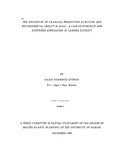| dc.description.abstract | Woodfuel consumption and related energy and ecological problems are important and
pressing issues in their own right. Since most Africans, Kenya included, are poor and can
afford or have access to little other than firewood, charcoal or even crop and animal residues
to meet their basic energy needs, woodfuels dominate the energy economics of virtually all
African countries. It's projected that it will take many years of rising incomes and
infrastructure development before such countries can make a transition from this massive
woodfuel dependence. As these wood resources diminish and recede, for millions of people,
the costs of obtaining woodfuels, whether in cash; to time for gathering them, are imposing
severe and increasing strains on already marginal households survival and production
strategies not to mention the harm posed on the environment.
Commonly, firewood is used in the rural areas and charcoal in the urban areas for cooking
and heating. As the rate of urbanization increases, the demand for charcoal will also
increase and hence the rate of deforestation.
This study sought to examine the factors which influence the local actors strategies as they
engage in charcoal production, and the environmental impacts thereof, in an ASAL area of
Kenya. A major objective of Kenya's forest policy has been self-reliance in wood products.
Not withstanding this, woodfuels have been almost totally" neglected by foresters, energy
specialists and development authorities. In large part this was by design. It has been
assumed that as courses develop economicall they must make a transition from
traditional fuels to petroleum, natural gas and hydro-electric power - the conventional
energy of the industrialized. world. But in the mid 1970s, much of the world was gripped by
the energy crisis of modern fuels and the shift was again disrupted and as a result, over-use
of woodfuels and the ensuing ecological and socio-economic problems have come to be
known as the "woodfuel crisis".
The author critically analyses the theoretical formulations in literature which govern local
actor's strategies as he interacts with his environment and the complexity of information
analysis in the mind of the actor. This formed the conceptual basis of this study. Also well reviewed are various concepts of energy and ecology which gives a bearing to the field of
study.
Primary data was obtained through observation, photography, key informants and interviews
with charcoal makers. Due to the legal status of the activity, tracer system was applied in
order to reach as many charcoal burners as possible, to conduct the interview.
Questionnaires were administered to fifty respondents who formed the sample size. The
secondary data was obtained from library research, research findings and government
publications. Various descriptive and inferential statistics were performed including
percentages, averages, and regression analysis. The data is graphically presented using bar
graphs, tables and pie-charts.
Major findings from this study indicate that, most of the charcoal burners are poor and
therefore charcoal burning was one of their coping strategies. The socio-cultural oriantation
of the local actors played a big role in influencing their actions and way of perceiving things.
Due to its ease of entry, many children dropped out of school in their early school age to
engage in charcoal burning and trading activity which is gaining popularity in the area and
this explains the low literacy level. The social and economic status of those involved in the
activity has not improved and a cycle of poverty has stalked the charcoal burners and their
families. The returns they get from the charcoal sales are so meagre that they only support
their subsistence level and many have taken up chang' aa drinking. This has really affected
their health a great deals Due to the more time spent on charcoal burning, little time was
dedicated to other .different' activities like f06d production, engaging in community
group activities, attending chief s meetings, etc .
It was also established that many people had knowledge on the importance of trees but were
ignorant of the consequences that may be brought by complete eradication of trees without
replacing them. Their attitude was that of "who cares" and in case trees get cleared up,
others will grow up to replace- them. Whatever stage.s or whichever source the trees would
come from was not featuring in their myopic minds since they had not initiated any effort to
plant trees.
A well thought solution that would treat the problem and not the symptom is the only way to help the situation. The problem of food, security and poverty were identified as the ones
featuring most and requiring immediate attention so that other recommendations can pick off
even with self-initiatives. A well fed person provided with food and security will go to school,
plant a tree, work for a cleaner and better paying job and educate others. | en |

